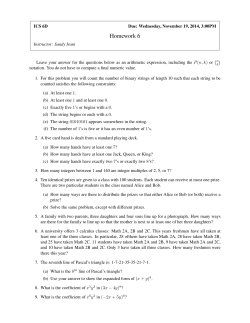
Static Detection and Automatic Exploitation of Intent Message
Static Detection and Automatic
Exploitation of Intent
Message Vulnerabilities in
Android Applications
Daniele Gallingani, Rigel Gjomemo,
V.N. Venkatakrishnan, Stefano Zanero
Android Message Passing Mechanism
Android apps are composed of
different components
Intents carry messages among
components and applications
Components declare the types
of intents they are willing to
receive
Intents can be sent explicitly or
implicitly
Motivation
Problem: Android Components
have no message origin
verification capabilities
Activity
Activity
An attacker can spoof legitimate
intents and send malicious input
Questions
- Could we check if applications validate input?
- If so, can we automatically generate exploit opportunities?
Contributions
• Static analysis method to automatically detect
data flows leading to sensitive operations
– Formulation of the problem as an IFDS problem
• Method for automatically generating exploits
that trigger malicious behavior
• Results
– Automatically generated exploits for 26
applications and showed they are vulnerable to
user interface spoofing attacks
Outline
•
•
•
•
Problem Statement
Approach
Implementation
Results
Problem Statement
String host = intent.getStringExtra("hostname");
String file = intent.getStringExtra("filename");
String url="http://www.example.com";
if (host.contains("example.com"))
url = "http://" + host + "/";
if (file.contains(".."))
file = file.replace("..", "");
String httpPar = toBase64(file);
...
DefaultHttpClient httpC = new DefaultHttpClient();
HttpGet get = new HttpGet(url+httpPar);
...
httpC.execute(get);
Problem Statement
String host = intent.getStringExtra("hostname");
String file = intent.getStringExtra("filename");
String url="http://www.example.com";
if (host.contains("example.com"))
url = "http://" + host + "/";
if (file.contains(".."))
file = file.replace("..", "");
String httpPar = toBase64(file);
...
DefaultHttpClient httpC = new DefaultHttpClient();
HttpGet get = new HttpGet(url+httpPar);
...
httpC.execute(get);
Source
Problem Statement
String host = intent.getStringExtra("hostname");
String file = intent.getStringExtra("filename");
String url="http://www.example.com";
if (host.contains("example.com"))
url = "http://" + host + "/";
if (file.contains(".."))
file = file.replace("..", "");
String httpPar = toBase64(file);
...
DefaultHttpClient httpC = new DefaultHttpClient();
HttpGet get = new HttpGet(url+httpPar);
...
httpC.execute(get);
Source
Sink
Problem Statement
String host = intent.getStringExtra("hostname");
String file = intent.getStringExtra("filename");
String url="http://www.example.com";
if (host.contains("example.com"))
url = "http://" + host + "/";
if (file.contains(".."))
file = file.replace("..", "");
String httpPar = toBase64(file);
...
DefaultHttpClient httpC = new DefaultHttpClient();
HttpGet get = new HttpGet(url+httpPar);
...
httpC.execute(get);
Source
• Finding paths from sources to sinks is not
sufficient
• Question: Are those paths feasible for an
attack?
Sink
Approach
• Input state: VI
• Exploit state(s): Ve
Value patterns related
to sinks
• Find relationship F
between VI and Ve,
such that Vi=F(Ve)
Source
Vi = {(v1, c1), …,(vn, cn)} = F(Ve)
Sink
Ve = {(ve1, ce1), …,(vem, cem)}
Approach Overview
Source
Sink
Approach Overview
• Path Computation
– Find all paths from sources to sinks
Source
Sink
Approach Overview
• Path Computation
– Find all paths from sources to sinks
• Symbolic Execution
– Generate a symbolic formula Fp
Source
C1
C1C2
C1C2 C3 = Fp
Sink
Approach Overview
• Path Computation
– Find all paths from sources to sinks
• Symbolic Execution
– Generate a symbolic formula Fp
• Exploit generation
Source
C1
C1C2
C1C2 C3 = Fp
– Solve Fp Ve VI
Sink
Fp Ve
Path Computation
• Supergraph contains CFGs of all the functions
• Taint Propagation
– Identifies statements that can be influenced by
attacker
– Reduces size of the problem
Implementation (Background)
• Path Computation: IFDS framework
(Soot&Heros)
– Transforms dataflow problems into graph
reachability problems
– Framework user defines a fact
– Framework user defines update rules for a fact
• Exploit Generation: Kaluza
– Efficient string solver
– Native support for many string operations
Implementation
• Path Computation
– A fact contains path and taint information for every
node
– Different rules update the fact information during
graph traversal
• Exploit Generation
– Translate FpVe into a Kaluza formula
– Additional string operations modeled using the Kaluza
language
E.g.,: a.contains(“test”) a \in CapturedBrack(/.*test.*/);
Results Overview
• 64 applications of different sizes
– 26 exploits generated and manually verified
• Sink statements: GUI operations
• Ve chosen to change apps GUIs (phishing)
• Different GUI targets
–
–
–
–
Entire screen change
Alerts screen change
User input fields
Other Components
Results
App
Entire Screen
Mint
Display an arbitrary web page inside an
Activity
GoSMS
Prompt to the user notification about a
new message with arbitrary sender and
SMS content
GoSMS
Prompt notification about a new message
received with arbitrary sender and
receiver
Yelp
Modify venue review draft screen and
enter review on behalf of the user
Poste Pay
Modify and show the application prompt
alerts with arbitrary messages
Craigslist
Change the Action Bar title,
compromising
the interface integrity
User Input
Alert Screen
Other Components
Attack
Results
Per-application execution time
Per-application components
Per-application vulnerable paths
Per-path statements
Per-path if-statements
Min
Max
Avg
2.4 min
3
2
5
0
33.2 min
31
19
81
3
12.3 min
24.5
4.2
17.2
0.98
• Very few validation checks present
– Mostly null pointers
• 31% of the String library functions
approximated with Kaluza
Limitations
• Untainted variables contribute to application
state. May introduce false positives
• Solver approximations. May introduce false
positives
Conclusions
• Conclusions
– We present an automatic method to discuver
vulnerable paths inside Android application
components
– Our method is modelled as an IFDS problem
– We provide proofs for the vulnerabilities under
the form of actual exploits, generated
automatically.
Questions?
© Copyright 2025










